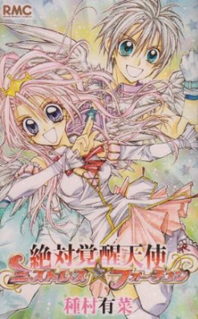
Manga are comics or graphic novels originating from Japan. Most manga conform to a style developed in Japan in the late 19th century, and the form has a long prehistory in earlier Japanese art. The term manga is used in Japan to refer to both comics and cartooning. Outside of Japan, the word is typically used to refer to comics originally published in the country.
Shōnenmanga (少年漫画), also romanized as shonen or shounen, are Japanese comics marketed towards young teen males between the ages of 12 and 18. The age group varies with individual readers and different magazines. The kanji character 少年 (shōnen) literally means "boy" or "youth", and the character 漫画 (manga) means "comic"; thus, the complete phrase means "young person's comic", or simply "boys' comic", with the female equivalent being shōjo manga. Shōnen manga is one of the most popular and best-selling forms of manga.

Manhwa is the general Korean term for comics and print cartoons. Outside Korea, the term usually refers to South Korean comics, although the comics industry is emerging in North Korea as well. Manhwa is a notable part of South Korean culture.

Animerica Extra was a monthly manga magazine published in by Viz Media. Established as a companion to the anime news and review magazine Animerica, Animerica Extra primarily published English-language translations of Japanese manga. The magazine shifted towards publishing shōjo manga in 2003, before ceasing publication in 2004.

Mai, the Psychic Girl, known simply as Mai (舞) in Japan, is a manga written by Kazuya Kudō and illustrated by Ryoichi Ikegami.
Takehiko Itō is a Japanese manga artist best known for his work on the manga Outlaw Star from his affiliated Morning Star Studio. He was also the primary creative mind behind other works of fiction set in the Toward Stars universe including the Uchuu Eiyuu Monogatari manga and Angel Links anime series.
Steve Oliff is an American comic book artist who has worked as a colorist in the comics industry since 1978.

Monthly Sunday Gene-X, often abbreviated as Sunday GX (サンデーGX), is a seinen manga magazine published by Shogakukan. Like many other manga magazines, it's an "anthology magazine" with each issue featuring new chapters of several manga series. The series are also published in book form as Sunday GX Comics.

Flower of Life is a slice of life comedy manga series by Fumi Yoshinaga revolving around a group of friends in a high school. The manga is serialised in Shinshokan's Wings. It was nominated for the first annual Manga Taishō award in 2008 and one of the Young Adult Library Services Association's 2008 Great Graphic Novels. The manga is licensed in North America by Digital Manga Publishing.

Aurora Publishing, Inc. was the American subsidiary of Japanese publisher Ohzora Publishing, the leading josei manga publisher in Japan. Headquartered in Torrance, California, it licensed and published Japanese manga for the North American market. Aurora Publishing's first release was Walkin' Butterfly under the shōjo imprint Aurora, which features manga targeting female readers in their teens and younger. Aurora Publishing also released manga under two other imprints: the yaoi imprint Deux Press featured female-oriented manga about homoerotic relations between beautiful men, while the josei imprint Luv Luv featured erotic romance manga targeting female readers in their late teens and up. Aurora Publishing distributed some of its manga via Netcomics. In 2010, the Aurora office in California closed. The former employees of Aurora Publishing went on to found Manga Factory. Manga Factory lasted until at least June, 2013 before it closed as well.
Koji Aihara is a Japanese manga artist from Hokkaido.

B.O.D.Y. is a shōjo romance and drama manga written and illustrated by Ao Momori. It was serialized in Bessatsu Margaret from 2004 until its conclusion in 2008 issue. The individual chapters were collected and published in 15 bound volumes by Shueisha, with the first volume released on April 23, 2004 and the final volume released on October 24, 2008.

Showa: A History of Japan, known in Japan as Comic Showa-shi, is a Japanese manga series written and illustrated by Shigeru Mizuki. A semi autobiographical work, this manga describes the author's experiences growing up during the Shōwa period. The author is a veteran of the Japanese army, but his series is filled with critical views of Japanese and American militarism.

Rica 'tte Kanji!? is a Japanese yuri manga series written and illustrated by Rica Takashima. The series was first serialized in the Japanese manga magazine Phryne in 1995, and then moved to Anise in 1996. The manga was later licensed by ALC Publishing for release in English, with the first volume being released on June 19, 2003. Additional Rica 'tte Kanji! stories have been published in ALC Publishing's annual anthology Yuri Monogatari. Rica Takashima has stated in interviews that one of the reasons she created Rica 'tte Kanji!? was to have a yuri manga that was happy and about everyday life, unlike most yuri of the time, which typically ended in tragedy or were in a sci-fi setting.

Red Colored Elegy is a one-shot Japanese manga written and illustrated by Seiichi Hayashi. The manga was serialized in manga magazine, Garo from 1970 to 1971. It is licensed in North America by Drawn & Quarterly, which released the manga on July 8, 2008. It was adapted into an original video animation by Toei Animation on June 21, 2007.

A Drifting Life is a thinly veiled autobiographical Japanese manga written and illustrated by Yoshihiro Tatsumi that chronicles his life from 1945 to 1960, the early stages of his career as a cartoonist. The book earned Tatsumi the Tezuka Osamu Cultural Prize, and won two Eisner Awards.

Mistress Fortune is a Japanese shōjo manga series written and illustrated by Arina Tanemura. The series debuted in the July 2008 issue of Ribon. It ran for a total of three chapters, ending in the September 2008 issue. Mistress Fortune was published in a single tankōbon in Japan by Shueisha on December 25, 2008.
Manga (漫画) are comics created in Japan, or by Japanese creators in the Japanese language, conforming to a style developed in Japan in the late 19th century. The term is also now used for a variety of other works in the style of or influenced by the Japanese comics. The production of manga in many forms remains extremely prolific, so a single list covering all the notable works would not be a useful document. Accordingly, coverage is divided into the many related lists below.

Opus is a Japanese seinen manga series written and illustrated by Satoshi Kon. The story is about a manga artist who is pulled into the world of the manga he is concluding and forced to confront his characters. The manga was serialized in the manga magazine Comic Guys from October 1995 until the magazine's cancellation in June 1996. It was collected into two volumes by Tokuma Shoten on December 13, 2010 and included a missing ending found after Kon's death. Dark Horse Comics licensed the manga in North America and released it in an omnibus edition on December 9, 2014. The French edition of the manga won the 2013 Asia Critics Prize from the Association des Critiques et des journalistes de Bande Dessinée and was nominated for the Sélection Officiele at the 2014 Angoulême International Comics Festival. Opus was Kon's final manga before he debuted in the anime industry with Perfect Blue.














